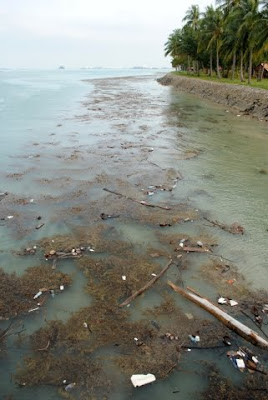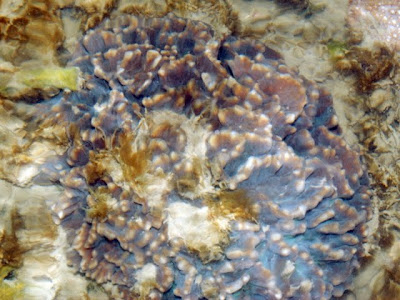Setting off from the pier, here we were back at Pulau Hantu again! It has been more than half a year since I've set foot on this island.
The tide was still a little high when we arrived. What caught our first attention will be a layer of floatsam ringing around the island.
It is the sargassum seaweed season. That explains the abundance of these seaweed as we can see from the jetty. However, there are also lots of thrash being washed to the side of the island including logs, plastic bottles and other stuffs. We are not too sure why this happened.
Against the setting sun, we look at the lagoon while the tide took its time to recede lower.
One of the first marine critter that greeted us will be none other than the real Hantu of Pulau Hantu. Not the ghost but this anemone. Why?
This Edwardsiid-looking anemone is probably Edwardsia hantuensis. This anemone was first described by England in 1987 from specimens taken at Pulau Hantu. Amazing isn't it!?
Here's a closeup of the hantu resident using an add on Raynox lens. The tentacles are banded and on each dark band, there are circle marks on it.
Later on towards the end of the trip, James saw another similar anemone.
As well as this near-transparent anemone which is another type of anemone. This is probably the Shy glass peacock anemone. These anemones have transparent tentacles that shrivel up and retract quickly when a torch or camera flash is detected.
I went to check out the resident Burrowing Giant Clam (Tridacna crocea) and am glad to know that it is still thriving well.
On my last trip in July 2010, coral bleaching was still ongoing. But we were all relieved that most of the corals have already recovered. Both soft corals and hard corals included. However, the sargassum mat was covering most of the reef, so we could not really have a good feel if the coral cover has been reduced due to bleaching last year.
Some uncommon corals encountered include this Brain anchor coral (Euphyllia ancora).
At the deeper ends of the reef, the water was deep (duh), slightly murky due to my foot stirring up sediments and the wind causing ripples. Thus photographing the rich coral cover there was a challenge. One of the few decent photos I've managed to take will be on this colony of Lettuce coral (Pavona sp.).
As well as this pretty Carnation coral (Pectinia sp.). I'm glad to see several colonies of these corals.

Another type of hard coral that were back in good numbers and unbleached will be the Mushroom corals.
I was thrilled to see this galaxy of Galaxy corals (Galaxea sp.)! There are so many healthy colonies! They have recovered from the bleaching.
At the very edge of the reef, I came across two really large Long-spined black sea urchin (Diadema sp.)! These urchins though scary looking, grazes on seaweed.
Ria found our first slug sighting. This is the Bohol nudibranch (Discodoris boholiensis).
Later on, I came across two more slug species. This is the Black phyllid nudibranch (Phyllidiella nigra) that ejected a bit of whitish substance as a defense mechanism when I touched it for a while.
While looking at blades of tape seagrass, I found another slug! This is the Gymnodoris nudibranch (Gymnodoris sp.).

The blades of the tape seagrass is full of interesting living organisms. Such as blob-like ascidians and even hydroids.

Juanhui saw what seems to be tiny sags of eggcases. From the sideview, there are pointy projections! I wonder what they are exactly!
More exciting creatures sighted on the reef include this squid (Family Loliginidae)...
A feeding Mosaic reef crab (Lophozozymus pictor)...
A super large Stonefish sea cucumber (Actinopyga lecanora)...
and also this fantastic find of the Spotted-tail frogfish (Lophiocharon trisignatus)!
What I thought was the most interesting sighting of the day will be this really tiny white Feather star (Order Comatulida) in the size of a 50 cent coin. :)
We ended the trip when the tide came back. By that time, it was really quite dark but the bright lights from Bukom refinery lit up the surrounding. Pulau Hantu is just a stone's throw away from Bukom. Yet marine life still thrives well with such proximity to development. Isn't this cool? :)
Sunday, January 23, 2011
An evening with the Hantu
Subscribe to:
Post Comments (Atom)




























3 comments:
Thanks for sharing this -- good to know life is flourishing on Hantu
very wonderful pictures! I was wondering, how do you get to Pulau Hantu?
hi there! you can find more details on how to get there here:
http://www.wildsingapore.com/places/hantu.htm
Post a Comment